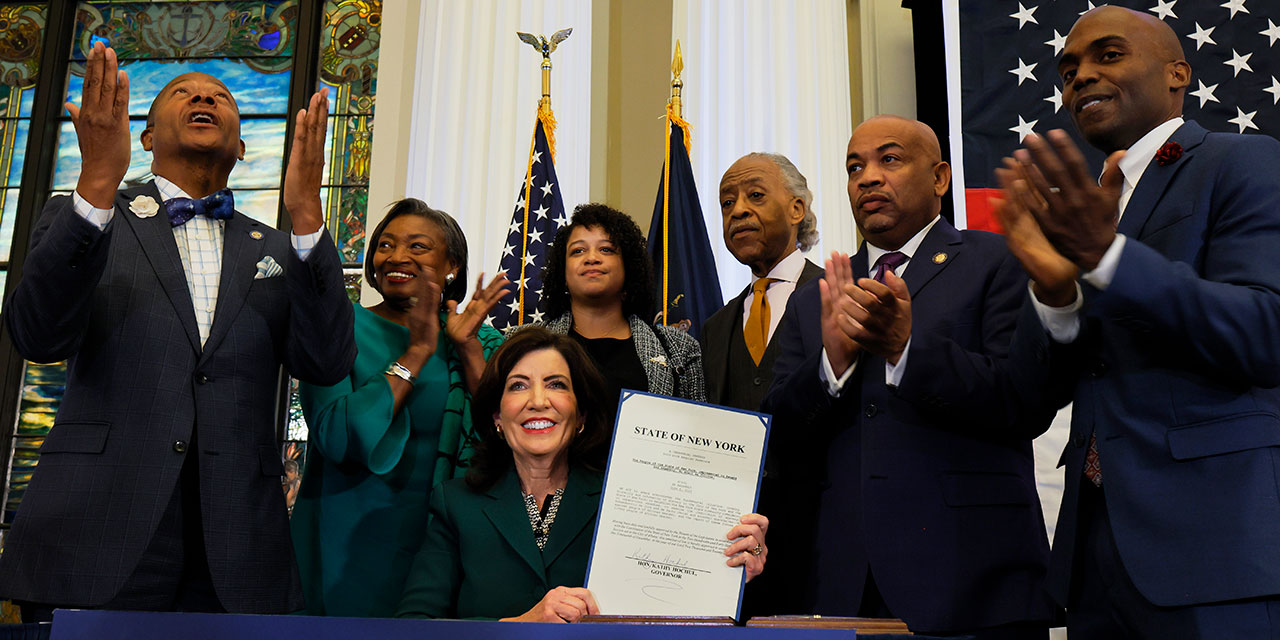
New York City recently took a small step forward in correcting historical wrongs—at least, that’s what lawmakers would have you believe. The city council has passed a legislative package that would “fully examine the present-day impacts of injustices inflicted on Black New Yorkers and communities” and “advance necessary efforts to consider potential remedies that can lead to healing and reconciliation.” These bills, now bound for the desk of Mayor Eric Adams for his signature, include the establishment of “a Truth, Healing and Reconciliation process on slavery within New York City” and a “reparations study” to determine how much money is owed to black New Yorkers because of slavery, abolished statewide in 1827.
The new bills complement New York’s statewide Community Commission on Reparations Remedies, which held its inaugural meeting this summer. The state commission will explore the “lingering negative effects of the institution of slavery and discrimination on living people of African descent and on society in the State of New York,” with a view to recommending “appropriate remedies and reparations” thereto. The chairwoman of the state commission, Jennifer Jones Austin, CEO of the Federation of Protestant Welfare Agencies, who also headed up the New York City Racial Justice Commission, kicked off the meeting by stating her aim to “embed racial justice and equity in core government functions.”
These various commissions within multiple, overlapping levels of government are presented as finders of fact, daring to investigate the unexplored history of the city and state to assess the ongoing damages of slavery. Councilman James Gennaro of Queens—one of a dwindling caucus of ten white men in the 51-member council—applauded the formation of a city-based reparations study, insisting that “no one should be afraid of a conversation, nobody should be afraid of a dialogue, a colloquy.”
You don’t have to be a master prognosticator to guess what kind of conclusion these commissions will reach. Just look to California, where the state’s 2022 Interim Report from the Task Force to Study and Develop Reparation Proposals for African Americans set what is likely to be the national model for defining the parameters of future reparations programs. This voluminous document, all 475 pages of it, explores every indignity and stolen opportunity that California—admitted to the Union in 1850 as a free state—has visited on its black population, though it’s worth noting that the percentage of state residents who were black did not reach 2 percent until World War II, and black California’s demographic share peaked at 7.7 percent in 1980.
Nevertheless, the California task force left no stone unturned in its tally of crimes. “State-funded California museums have excluded Black art from their institutions,” it declares. Further, “California has criminalized Black rap artists, as California courts have allowed rap lyrics to be used as evidence related to street gang activity.” Native-born black households, the report says, have on average $200 in total liquid assets; white households have 500 times more. And black Californians “have the highest rates of attempted suicide among all racial groups,” a statistic contradicted by every major study in the literature.
What does California—and America as a whole—owe black citizens and residents? The answer largely depends on what one chooses to calculate. The California task force cites one economist’s finding that “unpaid wages owed to enslaved people amounts to $19.4 trillion in today’s dollars,” derived by adding up all the hours that slaves worked between 1776 and 1865, multiplying that sum by the average prevailing wage, and then applying a 3 percent interest rate to the total. Nineteen trillion dollars is no trifling sum in the context of American capitalism; the market value of all U.S. traded stocks, after all, is $55 trillion. However, a 3 percent rate of interest, the report notes, is rather stingy: “merely doubling the interest rate to the more realistic six percent would increase the total estimate to $6.6 quadrillion in 2019 dollars.”
And that “more realistic” figure accounts only for unpaid wages for American slaves; it doesn’t touch on the costs of Jim Crow, redlining, racial violence, the role of racism as a health stressor, unfair prison time because of the War of Drugs, and so on. It’s hard to imagine white Americans getting away with settling their tab for much less than $25 quadrillion, or about 1,000 times the nation’s current GDP.
New York’s two reparations commissions may come up with different figures from those of the California task force, but two or three decimal places left or right aren’t really the point. No one believes that the United States will write its black citizens checks for tens of millions of dollars apiece. The real goal of these commissions is, as Jones Austin explained, to “embed racial justice and equity in core government functions.” Keeping the grievance train moving with multiplying and regenerative commissions and task forces forever, with plenty of gravy for the Federation of Protestant Welfare Agencies and its many not-for-profit cousins, remains the shining prize upon which the reparations industry affixes its eye.
Photo by Michael M. Santiago/Getty Images
City Journal is a publication of the Manhattan Institute for Policy Research (MI), a leading free-market think tank. Are you interested in supporting the magazine? As a 501(c)(3) nonprofit, donations in support of MI and City Journal are fully tax-deductible as provided by law (EIN #13-2912529).


